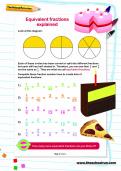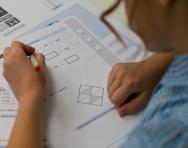Setting and streaming explained

As parents, we all have a natural tendency to compare our children with others and secretly hope that ours are outperforming their peers.
Finding out which ‘set’ or ‘stream’ they’re in at school can either reassure us that they’re doing well, or leave us worrying that they’re falling behind the rest of the class.
But how common are setting and streaming in primary school environments, and does your child’s set or stream influence how well they’re likely to do?
Setting and streaming explained
The terms ‘set’ and ‘stream’ are often used interchangeably, but they are in fact two separate ways of grouping children according to their academic ability.


Start a unqiue learning programme!
- Weekly programme for each school year
- Worksheets sent direct to your inbox
- Keeps your child's learning on track
Streaming is where children are placed in groups according to their general academic ability; a child who is considered to be a high achiever across the board may be put into the top stream.
Setting is where children are grouped by ability according to subject. So a child who is achieving highly in maths but is average at reading and spelling might be in the top set for maths, and the middle set for English.
Streaming and setting are more common in secondary schools than in primary schools. ‘Contrary to popular belief, all secondary schools adopt some form of ability grouping, although the extent of it for each year group may vary,’ explains Sue Hallam, professor of education and music psychology at UCL Institute of Education. ‘At secondary school, children are frequently banded into broad attainment groups, and then setted within those bands for particular subjects.’
In Year 7, children may be put into sets or streams based on their Year 6 SATs results, or on the results of CATs or other tests administered near the start of the year. A handful of secondary schools are ‘bilateral’, where the majority of children are given places non-selectively, but a percentage are admitted based on their 11+ results, and are taught as a separate ‘grammar stream'.
Although streaming and setting is less common in primary schools, some schools do group pupils according to ability. ‘It was common when selection at 11 occurred, when the top stream would be entered for the 11+ and the other streams would not,’ Sue explans. ‘Streaming had pretty much disappeared following the disappearance of the 11+ nationwide. However, there has been a resurgence lately.’ It’s thought that about 16 per cent of five- to seven-year-olds are taught in sets or streams.
There is a third option, which is more common in primary schools: within-class grouping in mixed ability classes. Here, children are split into small groups according to ability, but all stay in the same classroom and are taught by one teacher.
How do setting and streaming work?
Streaming or setting children in primary schools usually only happens when a school has more than one class in a year group, although sometimes children are put in sets across year groups. They might be put into sets, streams or groups based on teacher observations or on tests.
With both setting and streaming, each set or stream has its own teacher and is taught completely separately from the other sets or streams. Where children are grouped within the class, the same teacher will teach the whole class, but might set different work for each group: for example, a lower ability group may be tackling ‘challenge one’ while the higher ability children are given ‘challenge three’.
Once children have been put into a set or stream, it can be difficult for them to move. ‘Reviews of placement tend to be infrequent, and once in a group, children tend to stay there,’ Sue explains. Limits on class sizes often mean that if a teacher wants to move one child up, another has to move down.
Differentiated work in primary classrooms
An alternative to setting and streaming which is more common in primary schools is giving children differentiated work within their normal class. Within each class, a teacher will have pupils covering a wide range of abilities. Differentiated work means that the whole class is taught together, but children are given tasks that are appropriate to their academic ability, level of understanding and readiness to learn.
There are many different ways of differentiating work, including:
- Task: different tasks are set for children of different abilities. The teacher may print out three different maths worksheets – easy, moderate and difficult – to cover the range of abilities in the class.
- Group work: the teacher splits the class into small groups according to their ability, so they work on tasks with children who are at a similar level.
- Resources: this recognises that some children can work with more advanced resources than others. For example, in a Year 1 maths lesson, children who find addition and subtraction difficult may be given a number line to refer to, while children who are more capable are expected to use their mental maths skills.
- Pace: in a mixed class, higher ability children are sometimes held back by those who need longer to complete tasks. A classic example of differentiation by pace is where children who finish their work quickly are given an extension task.
- Teacher support and dialogue: this is one of the most commonly used methods of differentiating work in primary schools. After the teacher has explained the lesson plan and learning objectives to the whole class, they will go around the room and spend a few minutes with lower ability children, explaining the task in more detail and giving one-to-one support. This is often done by teaching assistants (TAs).
Where work is differentiated by task, there's usually a system so children recognise what level they're working at. So their worksheets may be graded 'challenge one, two and three,' or 'red, orange and green', for example. Sometimes, teachers will decide which task pupils should work on, based on their ability, but at other times, children are encouraged to choose for themselves based on how well they feel they understand the subject matter. However, teachers will always keep a close eye on which task children choose, to make sure they're selecting work of the right level.
The pros and cons of setting and streaming
Although setting and streaming might seem to have benefits in terms of allowing the teacher to tailor lesson content to the ability of their class and give each child the support they need at the right level, there is little evidence in favour of differentiating pupils by ability in sets or streams at primary school.
‘What tends to happen is that when children are streamed or set, the average level of attainment remains the same, but those in the lower and middle groups deteriorate while those in the top groups do better,’ Sue explains. ‘Teachers tend to believe that they are tailoring work to the level of the students, but the evidence suggests that expectations for the lower groups are too low.’
Another difficulty is that factors other than academic ability can affect which group children are placed in. For example, autumn- and winter-born children who have an age advantage are more likely to be in top sets or streams than the younger summer-born pupils. Boys are more likely to be in lower sets for literacy than girls. Children with behavioural issues are also prone to ending up in bottom sets or streams, regardless of their ability.
Setting or streaming can also be stigmatising for children. ‘For children in lower groups, there is a negative impact on their self-confidence and belief in themselves as learners,’ Sue explains. ‘Their attainment tends to decline compared to those not in ability groups, and they can become stigmatised as “thick”.’
There don’t, however, seem to be the same problems with within-class grouping. Studies have shown that this method of differentiating children according to ability has a positive impact on their achievement.
What to do if you’re worried about streaming
Primary schools are often at pains to make sure children and parents don’t realise that pupils have been setted, streamed or grouped, to avoid unhelpful comparisons between children. This is often done by giving the different groups names that are difficult to interpret – such as Owls, Hedgehogs and Foxes – rather than referring to them as the top/middle/bottom group, or groups one, two and three. But parents and children are often able to work out which group they’re in based on the level of work being set and which other children are in the same group.
If your child has been placed in a lower or middle group, don’t panic. Keep in mind that external factors – such as when your child was born – could be affecting their ability level as perceived by their teacher. Also remember that within-class grouping, in particular, tends to be flexible, and teachers can rearrange these groups as and when they think it’s necessary.
If you’re genuinely concerned that your child is being given work that is too easy or too hard, and that they’ve been placed in the wrong group, speak to the teacher about your worries. However, be wary of putting undue pressure on for your child to move groups. ‘If parents know that their child is in a low set or stream, they often complain and the child is moved up,’ says Sue. But this may not work to your child’s benefit if they end up being given work that stretches them too far and that they’re unable to keep up with.

Give your child a headstart
- FREE articles & expert information
- FREE resources & activities
- FREE homework help







